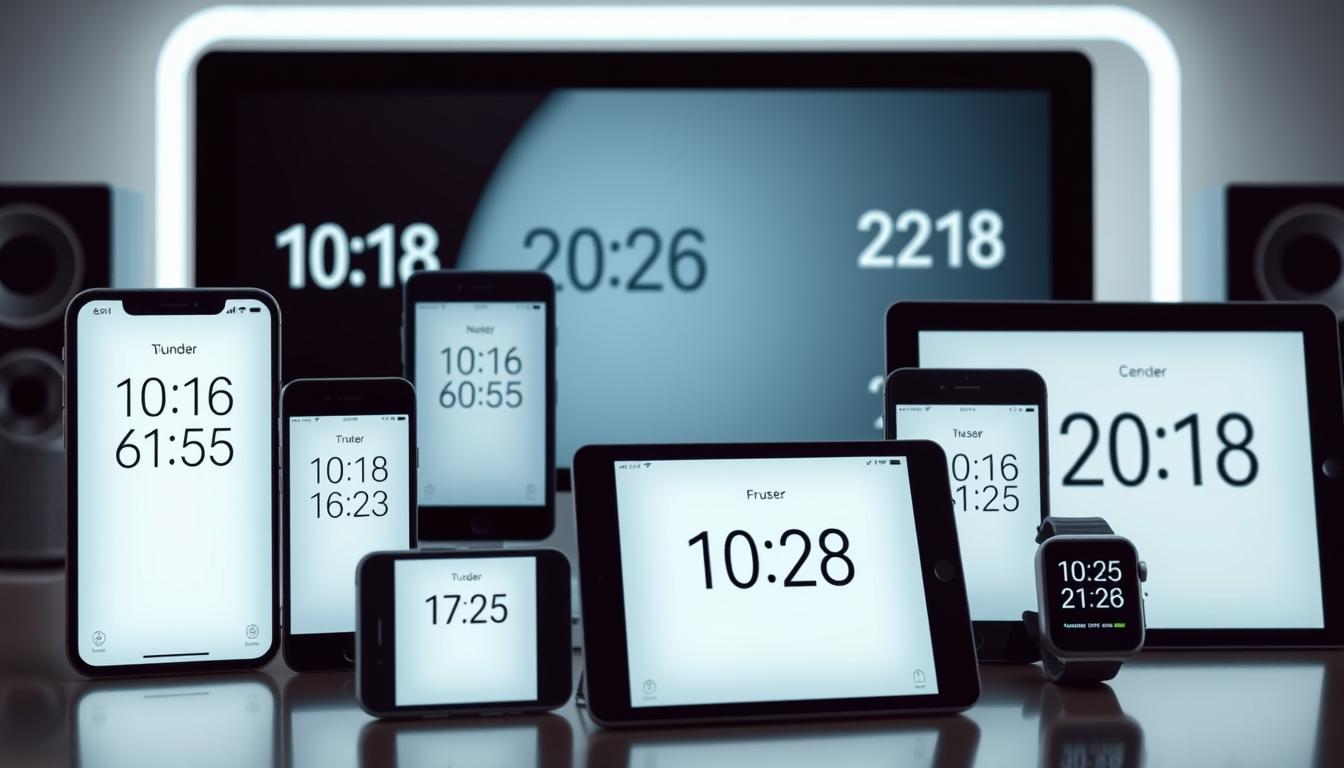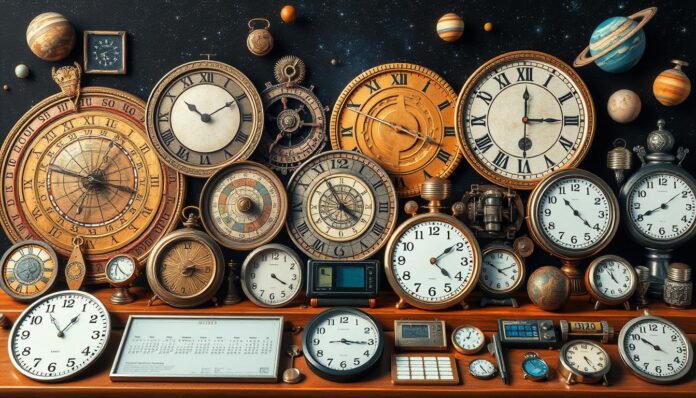This is a visually striking representation of various calendar systems and time measurement tools throughout history. It features ancient sundials, Gregorian and lunar calendars, modern digital clocks, and an array of timekeeping devices set against a cosmic background with stars and planets to symbolize the passage of time.
Our calendar system is a complex way to measure time. It links us to global rhythms and historical patterns.
Understanding the exact moment helps us navigate various experiences. Modern time tracking has evolved beyond simple date recognition.
Our calendar system developed over many centuries. It allows for precise event documentation and planning.
Knowing the current year gives essential context for scheduling. Time measurement is a universal language across cultures.
Technology has changed how we track time. Smartphones and digital devices keep us connected to the exact moment.
Understanding our place in time helps us make sense of experiences and predict future developments in society and technology.
Understanding the Current Year
The current year is a specific time tracked by the Gregorian calendar. This system helps us understand our place in history.
The Gregorian calendar uses the Common Era (CE) for dating. CE replaced the traditional Anno Domini (AD) system.
The calendar counts time by building on previous years. This creates a timeline for tracking events and milestones.
Scientists use this system to document research and record events. The standardized approach ensures clear communication across cultures.
The current year is more than just a number. It connects our past experiences with future possibilities.
The Gregorian Calendar Explained
Pope Gregory XIII changed how we track time in 1582. He fixed big problems with the old Julian calendar.
The new system uses leap years to match Earth’s orbit. Leap years happen every four years, with some exceptions.
Not all countries switched to the new calendar right away. Some took many years to change over.
Gregory’s calendar fixed timing issues and reduced drift. It’s more accurate than the old system.
Now, people all over the world use the Gregorian calendar. It shows how bright Gregory’s idea was.
Milestones in History for This Year
This year brings remarkable events and historical anniversaries that captivate the world. Scientific breakthroughs, political changes, and cultural milestones make this time unique.
Space missions explore distant planets and solar systems. New tech discoveries show our drive to understand the universe.
Research teams make prominent findings that could change science and tech. Cultural and social movements are growing fast.
Global teams tackle climate change, health, and growth issues. These efforts help solve big world problems.
Economic shifts change world trade and digital systems. New economies play more prominent roles in global markets.
Tech platforms create new ways to connect and grow business. Historical dates help us understand today’s world.
They remind us of past wins and inspire new ideas. Each milestone adds to humanity’s story of progress.
How to Find Today’s Date Easily
A collection of digital devices, including smartphones, tablets, and smartwatches, display various date formats on their screens. The devices are arranged artistically on a modern workspace with a sleek design, with soft glowing screens highlighting different styles of calendars and dates. The background is minimalistic and tech-inspired, focusing on the clarity and diversity of digital interfaces.
Modern digital devices make finding the current date a breeze. Smartphones, computers, and smartwatches show the date instantly.
Most devices display the date on home or lock screens. This keeps you informed about the current day.
Online tools offer many ways to check the date. Websites like Google show dates in search bars or headers.
Web browsers often display the date in the top corner. These tools support various date formats for different regions.
Digital devices have unique ways to show dates. iPhones show it on the lock screen.
Android devices display it in the notification bar. Desktop computers show dates in the system tray.
Smart home devices can tell you the date by voice. Just ask your Amazon Echo!
Online platforms let users switch between date formats. This helps travellers and remote workers track time accurately.
Many apps sync dates across devices for real-time updates. These tools keep you organized with precise date tracking.
Cultural Significance of Years
Different cultures give special meanings to specific years. They use extraordinary traditions like numerology and zodiac signs.
Asian cultures use zodiac signs to understand yearly cycles. The Chinese zodiac gives an animal each year.
People born in those years may get traits from their animal sign.
Numerology adds another way to look at years. Some cultures think specific years are lucky or hard.
These beliefs can guide big choices like when to marry. They show how time ideas can change people’s behaviour.
Many native cultures mark years using stars and spiritual practices. These traditions link people to their ancestors’ wisdom.
They help folks understand their place in the universe. Today, zodiac signs and numerology still interest many people.
These ideas mix old wisdom with new thoughts about growth. They help shape how we see ourselves and our culture.

The Future: What Lies Ahead?
New tech is changing our world fast. Experts see significant changes coming in how we live and work.
AI, quantum computing, and green energy will change many jobs and create new opportunities to solve big world problems.
Our society is changing quickly, too. Digital links will change how we talk and learn.
Remote work and online school are becoming routine. They’re breaking down old walls between places.
Future health tech looks fantastic. New medicine and tools might help us live longer.
Smartwatches and AI health checks will get better. They’ll be easier for everyone to use.
Climate tech is essential. New ways to build and make energy will help our planet.
Cities might change a lot. They could have smart power grids and clean cars.
New tech is exciting, but it brings questions. We need to think about privacy and data safety.
We’ll need to work together around the world. We must use new tech in good ways.
The Influence of Technology on Timekeeping
Tech has changed how we track time. Atomic clocks lead in precise timekeeping, using quantum mechanics for accuracy.
These devices power crucial global systems. They measure seconds with unmatched precision.
GPS time sync is another timekeeping breakthrough. Satellite networks coordinate global positioning with millisecond accuracy.
This enables smartphone navigation and financial trading. Digital calendars now integrate complex scheduling across devices.
Modern timekeeping goes beyond simple date tracking. Advanced tech allows real-time sync across continents.
This makes time zones almost irrelevant. Scientists keep developing more accurate ways to measure time.
Digital timekeeping shows our need for instant, precise info. Tech has changed how we see and use time.
It’s made our world more connected. Our lives are now more efficient than ever before.
Fun Facts About the Current Year
This year offers exciting trivia for curious minds. Numerical patterns reveal fascinating connections across different domains.
The calendar year shows unique math symmetries. These intrigue both mathematicians and casual observers.
Astronomical events mark key moments in our celestial calendar. Stargazers can enjoy meteor showers, planetary alignments, and solar activities.
These cosmic displays remind us of the universe’s nature and show our planet’s place in it.
Technology pushes boundaries with groundbreaking innovations this year. AI and quantum computing see breakthroughs.
Researchers uncover new insights about our world. These challenge what we thought we knew.
Cultural milestones and global events enrich the year’s story. Anniversaries, competitions, and social movements make this year memorable.
Each moment adds to the human experience. They connect people across different communities and backgrounds.
FAQ
How do I determine the current year?
Digital devices like smartphones and computers show the current year. You can also check the year’s online calendars.
Most devices display the year using the Gregorian calendar system, also used in digital clocks and settings.
What is the Gregorian calendar?
The Gregorian calendar is the most used civil calendar worldwide. Pope Gregory XIII introduced it in 1582 to replace the Julian calendar.
It offers a more exact way to track time. The system also has a precise method for figuring out leap years.
Why do we use the current year numbering system?
Our year numbering system is based on the Gregorian calendar. We use Anno Domini (AD) or Common Era (CE) notation.
This system counts years from Jesus Christ’s believed birth year. It has become the global standard for keeping time.
How often do leap years occur?
Leap years usually happen every four years, with some exceptions. A year is a leap year if it can be divided by 4.
Century years must be divisible by 400 to be leap years. This keeps our calendar in line with Earth’s orbit.
Can different cultures have different year numbers?
Yes, many cultures use their calendar systems. The Chinese, Islamic, and Hebrew calendars count years differently.
These calendars may show different current years compared to the Gregorian calendar.
How accurate are modern timekeeping methods?
Thanks to atomic clocks and GPS, modern timekeeping is very precise. These tools can measure time down to nanoseconds.
This ensures reliable time tracking across global systems.
How can I quickly check the current date?
Look at digital devices like smartphones, computers, or smartwatches for the current date. Many websites and electronic devices also show the date and time.
Do technological advancements affect how we track time?
Yes! Technology has changed timekeeping through digital calendars and automatic syncing. World clock apps and atomic clocks make tracking time more straightforward and accurate.
Why do some people find the current year significant?
People may see the current year as necessary due to personal milestones. Historical events, cultural celebrations, or number meanings can also make a year special.
Each year brings unique experiences that can make it memorable.
You can also read more : Understanding Starbucks Partner Hours: A Comprehensive Guide



